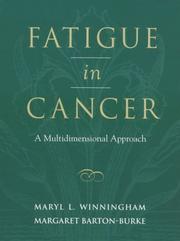| Listing 1 - 7 of 7 |
Sort by
|
Book
ISBN: 0867206438 Year: 1992 Publisher: Boston London Jones and Bartlett Publishers
Abstract | Keywords | Export | Availability | Bookmark
 Loading...
Loading...Choose an application
- Reference Manager
- EndNote
- RefWorks (Direct export to RefWorks)

ISBN: 0763706302 Year: 2000 Publisher: Boston Jones and Bartlett
Abstract | Keywords | Export | Availability | Bookmark
 Loading...
Loading...Choose an application
- Reference Manager
- EndNote
- RefWorks (Direct export to RefWorks)
Cancer --- Fatigue --- Neoplasms --- Complications --- complications
Book
ISBN: 0702046221 0702033693 9780702033698 9780702046223 Year: 2011 Publisher: New York : Churchill Livingstone/Elsevier,
Abstract | Keywords | Export | Availability | Bookmark
 Loading...
Loading...Choose an application
- Reference Manager
- EndNote
- RefWorks (Direct export to RefWorks)
Lungs -- Diseases. --- Respiratory Tract Diseases --- Respiratory System --- Anatomy --- Diseases --- Lung Diseases --- Lung --- Medicine --- Health & Biological Sciences --- Respiratory System Diseases --- Lungs --- Diseases. --- Pulmonary diseases
Digital
ISBN: 9780702046223 0702046221 Year: 2011 Publisher: New York Churchill Livingstone/Elsevier
Abstract | Keywords | Export | Availability | Bookmark
 Loading...
Loading...Choose an application
- Reference Manager
- EndNote
- RefWorks (Direct export to RefWorks)
With an emphasis on practical diagnostic problem solving, Pathology of the Lungs 3e provides the pulmonary pathologist and the general surgical pathologist with an accessible, comprehensive guide to the recognition and interpretation of common and rare neoplastic and non-neoplastic lung conditions. The text is written by two authors and covers all topics in a consistent manner without the redundancies or lapses that are common in multi-authored texts. The text is lavishly illustrated with the highest quality illustrations which accurately depict the histologic, immunohistochemical and cytologic findings under consideration and it is supplemented throughout with practical tips and advice from two internationally respected experts. The user-friendly design and format allows rapid access to essential information and the incorporation throughout of relevant clinical and radiographic information makes it a complete diagnostic resource inside the reporting room. Approximately 1,000 high quality full color illustrations. Provides the user with a complete visual guide to each specimen and assists in the recognition and diagnosis of any slide looked at under the microscope. Comprehensive coverage of both common and rare lung diseases and disorders. One stop consultation resource for the reporting room or study, no need to go further to get questions answered. Clinical background and ancillary radiographs incorporated throughout. Provides the user with all of the necessary diagnostic tools to make a complete and accurate pathologic report. Practical advice and tips from two of the world's recognized experts. Provides the trainee and general surgical pathologist with time saving diagnostic clues when dealing with difficult specimens. Consistent and uniform approach incorporated for each disease and disorder (Etiology, pathogenesis, clinical features, pathologic features, differential diagnosis) User-friendly format enables quick and easy navigation to the key information required.
Book

Year: 2013 Publisher: Washington, D.C., The World Bank,
Abstract | Keywords | Export | Availability | Bookmark
 Loading...
Loading...Choose an application
- Reference Manager
- EndNote
- RefWorks (Direct export to RefWorks)
This paper summarizes the literature on the impact of state subsidized or social health insurance schemes that have been offered, mostly on a voluntary basis, to the informal sector in low- and middle-income countries. A substantial number of papers provide estimations of average treatment on the treated effect for insured persons. The authors summarize papers that correct for the problem of self-selection into insurance and papers that estimate the average intention to treat effect. Summarizing the literature was difficult because of the lack of (1) uniformity in the use of meaningful definitions of outcomes that indicate welfare improvements and (2) clarity in the consideration of selection issues. They find the uptake of insurance schemes, in many cases, to be less than expected. In general, we find no strong evidence of an impact on utilization, protection from financial risk, and health status. However, a few insurance schemes afford significant protection from high levels of out-of-pocket expenditures. In these cases, however, the impact on the poor is weaker. More information is needed to understand the reasons for low enrollment and to explain the limited impact of health insurance among the insured.
Book

Year: 2013 Publisher: Washington, D.C., The World Bank,
Abstract | Keywords | Export | Availability | Bookmark
 Loading...
Loading...Choose an application
- Reference Manager
- EndNote
- RefWorks (Direct export to RefWorks)
This paper summarizes the literature on the impact of state subsidized or social health insurance schemes that have been offered, mostly on a voluntary basis, to the informal sector in low- and middle-income countries. A substantial number of papers provide estimations of average treatment on the treated effect for insured persons. The authors summarize papers that correct for the problem of self-selection into insurance and papers that estimate the average intention to treat effect. Summarizing the literature was difficult because of the lack of (1) uniformity in the use of meaningful definitions of outcomes that indicate welfare improvements and (2) clarity in the consideration of selection issues. They find the uptake of insurance schemes, in many cases, to be less than expected. In general, we find no strong evidence of an impact on utilization, protection from financial risk, and health status. However, a few insurance schemes afford significant protection from high levels of out-of-pocket expenditures. In these cases, however, the impact on the poor is weaker. More information is needed to understand the reasons for low enrollment and to explain the limited impact of health insurance among the insured.
Book

Year: 1981 Publisher: Brunswick (Maine) Bowdoin College Museum of Art
Abstract | Keywords | Export | Availability | Bookmark
 Loading...
Loading...Choose an application
- Reference Manager
- EndNote
- RefWorks (Direct export to RefWorks)
Art --- Bowdoin College
| Listing 1 - 7 of 7 |
Sort by
|

 Search
Search Feedback
Feedback About UniCat
About UniCat  Help
Help News
News